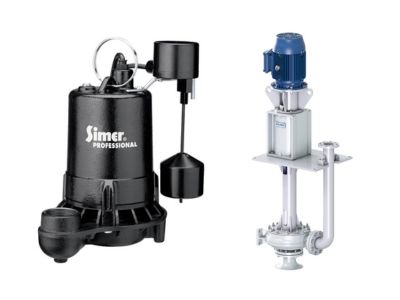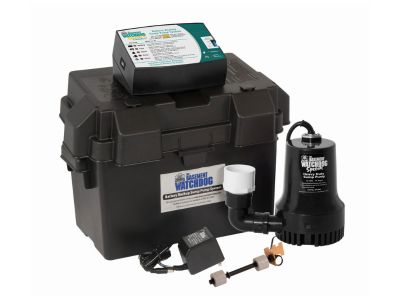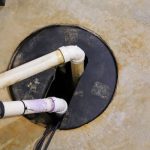Why Homeowners Should Consider a Sump Pump Installation
When homeowners create their holiday wish lists or to-do lists this season, they should consider adding an item they might not think of – a sump pump. Sump pumps help homeowners save money and time by helping prevent flooding and water damage in their homes. This post will explain how sump pumps work, their benefits, and the types of sump pump systems.
Reasons to Install a Sump Pump
Sump pumps are often overlooked when it comes to home maintenance, but they play a crucial role in keeping homes and basements dry and preventing water damage. These devices are typically installed in the lowest part of a home, like a basement or a crawlspace, and work by collecting excess water and directing it away from the home’s foundation. Here are some reasons why installing a sump pump is beneficial:
- Prevents flooding: One of the main benefits of a sump pump is that it helps to prevent flooding. When living in an area with heavy rainfall or a high water table, the home and basement could be at risk of flooding without a sump pump.
- Protects the foundation: Excess water around the home’s foundation can cause damage over time, leading to costly repairs. A sump pump helps to keep the area around the foundation dry, preventing potential structural issues.
- Prevents water damage: Excess water in a home can cause significant water damage and lead to costly repairs. Sump pumps are essential tools for preventing water damage in basements and crawl spaces, protecting the property and belongings.
- Reduces mold and mildew: With excess moisture in a home or basement comes the risk of mold and mildew growth. This also poses a health hazard. A sump pump can help prevent mold and mildew growth by keeping the space dry.
- Increases home value: Many homebuyers consider the presence of a sump pump when looking at potential homes. Installing one can increase the value of a property and make it more attractive to buyers in the future.
Common Types of Sump Pumps
 There are numerous types of sump pumps available, but the two main types of primary sump pumps are submersible sump pumps and pedestal sump pumps. Here are some pros and cons of these common sump pump systems:
There are numerous types of sump pumps available, but the two main types of primary sump pumps are submersible sump pumps and pedestal sump pumps. Here are some pros and cons of these common sump pump systems:
- Submersible sump pump: The motor for this sump pump system is located inside a sump pump basin and runs underwater. This system is more expensive than the other type and has a shorter lifespan, but it is more powerful and runs quieter.
- Pedestal sump pump: This system has a motor above the sump pit. Because the motor is outside the basin, it is louder than the submersible pump, but the location makes it more convenient for plumbers to repair. They are also more affordable and have a longer life expectancy but aren’t as powerful.
Sump Pump Backup Options
 In some situations, homeowners may need a secondary or backup sump pump to help protect their homes from flooding. A backup is important if homes get heavy rain or experience power outages. A backup unit can help pump away large amounts of water to prevent flooding, even during a power outage when the primary pump cannot operate. A backup also helps when a sump pump is malfunctioning, allowing the second pump to take over. Some popular backup sump pump options are:
In some situations, homeowners may need a secondary or backup sump pump to help protect their homes from flooding. A backup is important if homes get heavy rain or experience power outages. A backup unit can help pump away large amounts of water to prevent flooding, even during a power outage when the primary pump cannot operate. A backup also helps when a sump pump is malfunctioning, allowing the second pump to take over. Some popular backup sump pump options are:
- Battery backup for the sump pump
- Water-powered sump pump backup
- Portable backup generator
About Performance Plumbing
Performance Plumbing has been serving Ball Ground, GA, and the surrounding areas since 2016. They provide straightforward pricing, financing, and free in-person estimates. Call them today for sump pump repair and installation services in Ball Ground, GA.
Distribution Links +
- lifestyle.myeaglecountry.com
- newsnetmedia.com
- atlanta.newsnetmedia.com
- augusta.newsnetmedia.com
- austin.newsnetmedia.com
- boise.newsnetmedia.com
- buffalo.newsnetmedia.com
- columbia.newsnetmedia.com
- columbus.newsnetmedia.com
- detroit.newsnetmedia.com
- fresno.newsnetmedia.com
- jacksonville.newsnetmedia.com
- losangeles.newsnetmedia.com
- minneapolis.newsnetmedia.com
- monterey.newsnetmedia.com
- myrtlebeach.newsnetmedia.com
- nashville.newsnetmedia.com
- norfolk.newsnetmedia.com
- odessa.newsnetmedia.com
- pittsburgh.newsnetmedia.com
- portland.newsnetmedia.com
- quincy.newsnetmedia.com
- sacramento.newsnetmedia.com
- saltlakecity.newsnetmedia.com
- sanantonio.newsnetmedia.com
- santabarbara.newsnetmedia.com
- siouxfalls.newsnetmedia.com
- waco.newsnetmedia.com
- sports.newsnetmedia.com
- lifestyle.roanokenewstalk.com
- https://smb.valleytimes-news.com
- https://smb.lowndessignal.com
- https://pr.washingtoncitypaper.com
- https://smb.theleesvilleleader.com
- https://smb.prentissheadlight.com
- https://smb.beauregardnews.com
- https://pr.hattiesburg.com
- https://pr.bradfordvillebugle.com
- https://pr.boreal.org
- https://pr.stylemg.com
- https://pr.walnutcreekmagazine.com
- https://pr.thembnews.com
- https://pr.timesofsandiego.com
- https://pr.chestercounty.com
- https://pr.wncbusiness.com
- https://pr.ashlandtownnews.com
- https://pr.franklintownnews.com
- https://pr.hollistontownnews.com
- https://pr.hopedaletownnews.com
- https://pr.naticktownnews.com
- https://pr.millismedwaynews.com
- https://pr.norfolkwrenthamnews.com
- https://pr.norwoodtownnews.com
- https://pr.omahamagazine.com
- https://pr.greenvillebusinessmag.com
- https://pr.davisjournal.com
- https://pr.columbiabusinessmonthly.com
- https://pr.mysugarhousejournal.com
- https://pr.herrimanjournal.com
- https://pr.holladayjournal.com
- https://pr.murrayjournal.com
- https://pr.millcreekjournal.com
- https://pr.midvalejournal.com
- https://pr.draperjournal.com


